and Society (CLICCS)
How News Magazines Frame our Future with Climate ChangeFrom Global Doom to Sustainable Solutions
25 March 2022, by Franziska Neigenfind

Photo: Details below article
When it comes to climate change, many people rely on the media to keep informed. But how our future could look like is portrayed in a variety of ways. Journalists create powerful visions that can promote climate-friendly behavior. A team led by Prof. Michael Brüggemann and Dr. Lars Guenther has investigated how these images of our future with climate change are constructed.
How are visions of our climate future created in the media?
Michael Brüggemann: Journalists not only “translate” climate research for the public; they also select specific notions about the future. In the process, they embed information in different interpretational frameworks – which we refer to as “frames”. This has nothing to do with manipulation; it’s simply due to the fact that human communications always take place in specific contexts.
Could you give us a few examples?
Lars Guenther: These interpretational patterns apply to positive and negative climate futures alike. Sustainability and opportunities stand for positive visions, while the catastrophic impacts of global warming represent negative ones. We analyzed four international newsmagazines from the 1980s to 2019, and gathered issues of India Today, Der Spiegel, the Economist and Time Magazine with a reference to climate change on the cover page. One exciting aspect here are the combined frames of the texts and images.
And what do they predict for our future?
Michael Brüggemann: Especially some of the early cover stories from the 1980s and 1990s show a vision of the future that could essentially be described as “global doom” – and portray it using extreme scenarios for our planet. These stories use alarming and apocalyptic terminology and imagery. The second frame, “local tragedies,” is similar but more regionally focused and therefore more concrete. It concentrates on the impacts of climate change in specific regions. Here, the covers and articles are characterized by photographs of storm damage, dead fish, bleached-out corals, or people fighting wildfires in the Amazon or California.
And the more optimistic perspective?
Lars Guenther: The third frame is more concerned with “sustainable solutions”: many of these articles treat global warming of 1.5 or 2 degrees Celsius as a fact and focus on ways of limiting warming to the respective level. Here, many of the cover images have a global motif and use individuals like Greta Thunberg or address local topics, but use symbolic images to do so, for instance a picture of a tree inside a lightbulb to symbolize innovative ideas.
What are the effects of these portrayals?
Michael Brüggemann: Generally speaking, the frames have become more diverse and complement one another. That’s a good way to encourage climate-friendly choices. They show the very serious problems that climate change entails, while also highlighting our options. Images of potential solutions and measures give people hope. We’ve also seen that portrayals of local impacts can be particularly effective in terms of increasing people’s awareness of the problem and their willingness to support political measures. Since the 2000s, a shift toward portrayals of a more sustainable future can be seen.
Picture Credits Collage: UHH/CLICCS/Franziska Neigenfind: Anders Hellberg (CC-BY-SA-4.0); PIRO4D/Pixabay; Sebastien Marty/Pixabay; Bianca Van Dijk/Pixaby; lanur/Pixabay; John Middelkoop/Unsplash
CLICCS Quarterly
The article was published in CLICCS Quarterly, the news from the Cluster of Excellence every three month. Find full issue -> here.
Publication: Lars Guenther, Michael Brüggemann & Shorouk Elkobros: From Global Doom to Sustainable Solutions: International News Magazines’ Multimodal Framing of our Future with Climate Change


